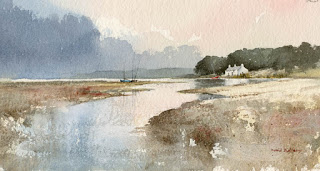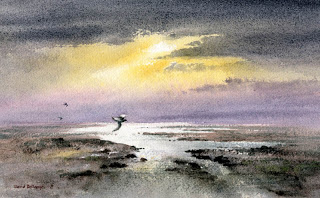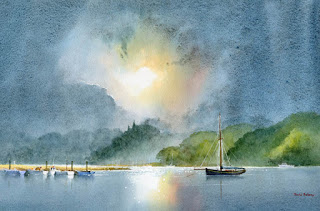Some of the simplest watercolours can have the most impact, and one of my favourites in this category is a watercolour sketch done of the Middim Khola river in Nepal, carried out at speed.
Most of this was done with a mixture of French ultramarine and cadmium red, with burnt umber replacing the red for the closer, stronger tones, and closer in the foreground and right-hand trees I have also dropped in some yellow ochre. The strong backlighting eliminated most detail and created a powerful sense of a series of tones that automatically suggested a vast space. Here and there I have deliberately lost the edges of ridges and the shorelines of the river, and emphasised others. Evenings are a good time to capture this sort of effect with backlighting, which also creates a sparkling effect of water. If you are working directly from the scene try painting a monochrome as it is quicker and you can capture the effects before they disappear!
This sketch was carried out during a painting expedition when I took a group of painters trekking in the Himalayas. That morning we had descended from some considerable height and one of our more elderly artists was missing as we sat on the banks of the river for lunch. I wasn’t too worried as she had a Sherpa allocated to look after her full-time, but we waited in expectation of her arrival. She wore a large distinctive white hat and when I gazed up at the mountain we’d descended I suddenly caught sight of what I assumed was her hat coming out of the trees like a bat out of hell. I couldn’t believe it, as she would never have been able to move at such speed, so I grabbed my binoculars and focused them on the hat.
Sure enough, it was our missing artist, hurtling down the mountainside at astonishing speed. She was actually sitting piggy-back style on the back of the diminutive little Sherpa and he was running down the mountain! These little fellows are incredible, and he was quite a bit smaller than our artist friend. They then disappeared into more trees and about fifteen minutes later came sauntering side-by-side out of the bushes on the far side of the river. There were many tales on that trip and it was quite tough for many, but they all relished the experience of a lifetime.
Stay safe and keep painting!






